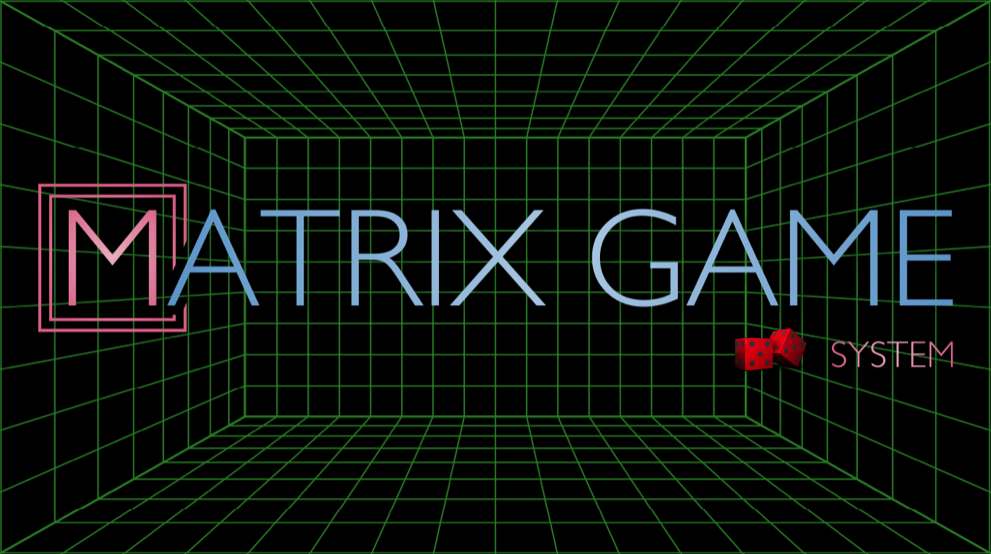MATRIX GAME SYSTEM OVERVIEW

Matrix Games for Sense-making of Future Strategies and Concepts
Matrix games can serve many purposes and methods. For example, think tanks have used matrix games to assist with sense-making of future strategies and concepts and help with generating new insights. Overall, the respective interests of these different users of matrix games determine the focus of their gaming efforts.
Matrix Game Narrative Methodology
Matrix narrative methodology was created in the United States by Chris Engle and was first published in 1992. Engle aimed to create a system by which it was possible for a player to role-play at any level, representing anything from a single person to an entire country. Subsequently the method was developed extensively and play tested in a variety of professional military educational contexts over the next fifteen years. By now matrix games have been used for professional military education in the United Kingdom, including to study current conflicts, such as those in Syria, Libya, and Iraq, as well as hypothetical conflicts in such hot spots as the South China Sea and the Korean Peninsula. Those working in intelligence also have used them. Matrix games exist in the space between rules-based games and online role-playing games. Many of the existing rules-based games take considerable time and effort to explain to those from a non-gaming background. Rather than attempting to come up with rules to cover all possible actions, the matrix games are very light on rules. Players state what they want to do, the expected impact, and give reasons supporting why their efforts would succeed. Other players then are allowed to suggest factors that would increase or decrease the chance of success. On this basis, the umpire normally assigns a probability in the form of handicap score to the chance of success of the players’ actions. This method encourages creative thinking but has a structure that uses the experiences of the group to help moderate the suggestions. Having a team represent and role-play each actor in the game helps encourage analytical discussion; for each turn, the team is given a short time to agree on a course of action. One of the strengths of matrix games is the ability to integrate pol-mil actions within a single game. Since players can make arguments about whether another player’s proposed actions would succeed, the game had some elements of both competition and cooperation. This method allows a situation to be explored quickly without the constraint of cumbersome game mechanics. Game designers developed many variations of matrix games, customizing them to their purposes.
Fundamentally, the methodology employed in a matrix game is referred to as a “narrative” method for engaging players in sense-making. Matrix games serve an important role in gaming current and potential crises. By creating a space where key stakeholders can manage specific situations involved in controlling and predicting scenarios, there is room to learn about the thinking and maneuvering behind current world events. While the matrix game methodology employs narrative to strengthen the game play, it also assumes a certain level of expertise in the subject being gamed. Preparing a primer pack before the game is essential, and the effort involved in creating such a succinct summary can be a useful analytical exercise in itself. Further, it is clear that issuing players a pre-game narrative of background information helps provide the foundations onto which game play can be introduced. Players are not simply set to work on some prescribed aims and objectives; they possess a cultural overview that helps provide the basis for actions within the game.
The matrix game narrative methodology can be a useful tool for examining complex scenario dynamics, in which strategies are not initially apparent and the interplay of divergent multiple actors cannot be predetermined or reasoned out even with careful examination of the situation. Like all games, a matrix game cannot predict the future, but it can lay out a narrative for a particular future scenario. Conducting multiple replays can generate more scenarios.
Advanced Usage of Matrix Games By Strategy and Concepts AI-prompt Engineers
The Matrix Game System also offers integrative use of the OpenAI GPT models, to include GPT 4o (omni), by strategy and concepts AI-prompt engineers for creating unique insights in the examination of complex challenges, developing sense-making narratives, and assessing prospects of potential strategy scenarios over the course of changing or unfolding events. Basically, prompt engineers are skilled at determining highly effective prompts for use with an AI system for obtaining effective AI assistance with query responses for helping with specific issues or challenges. In cases involving complex challenges, teams of prompt engineers from across targeted domains, apply disciplinary, multidisciplinary, and transdisciplinary knowledge to craft prompts highly effective for obtaining AI assistance useful for addressing complex tasks or challenges. This usage of the Matrix Game System offers means for teams of strategists to use red teaming and AI-prompt engineers with OpenAI GPT models as an advanced tool for evaluating and modifying strategy at various levels; this includes helping to develop future strategists in gaining experience and skills for effective usage of generative AI systems by strategy human-AI teams.
Overall, the Matrix Game System can be used to conduct a variety of game settings to include in-residence and blended combinations involving resident, online (to include immersive VR) participates. Access to the Matrix Game System is password protected. Matrix Game System sub-dashboards are illustrated below.
MATRIX GAME SYSTEM DASHBOARD DEPICTED BELOW
The Matrix Game System dashboard, depicted visually below, offers sub-dashboards for each feature or function offered by the system. The immersive VR version of the Matrix Game System also offers interactive 3D models for use by an umpire and each team.







